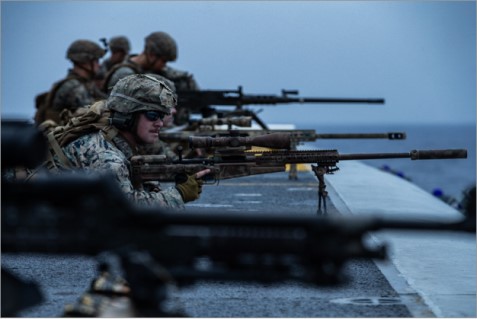There is mounting interest in the near- and long-term effects of low-level overpressure (LLOP), shock wave-induced pressure that occurs outside of the normal atmospheric pressure, on Warfighter health and performance. Specially trained military and law enforcement officers are exposed to these forces periodically or annually throughout their time in service. These cohorts experience low-level repetitive exposure through training exercises as well as in real-world, operational scenarios including heavy-wall breaching, handling 0.50-caliber sniper rifles, and/or during hand-grenade throwing exercises. There is a growing body of evidence that personnel exposed to periodic LLOP can experience adverse symptomatology that resembles mild traumatic brain injury (TBI) or concussion such as headaches, fatigue, and dizziness that depreciates performance. The objective of a recent retrospective cohort study1 was to evaluate whether military and law enforcement personnel regularly exposed to LLOP and identified as “fit for duty” experience these adverse symptoms and express neurotrauma biomarkers.
Over a two-year period (January 2017-October 2019), researchers collected samples and survey data from 106 healthy, male active-duty military and law enforcement personnel (18+ years old) with prior low-level overpressure exposure. These personnel were determined to be “fit for duty” by their supervisors and not diagnosed with TBI or acute blast exposure throughout the course of the study. The samples were compared to those obtained from 30 control individuals (healthy men without disease) from a commercial vendor. Participants completed a survey of their operational and medical history as well as symptoms experienced.

The results indicated that serums levels of neurotrauma biomarkers (e.g., glial fibrillary acidic protein, ubiquitin carboyx-terminal hydrolase L1 (UCH-L1), tau protein, and amyloid beta proteins (Aβ-40 and Aβ-42)) were elevated in this cohort when compared to control samples. In particular, the serum levels for Aβ-40 and Aβ-42 were at least 50 times higher among study participants when compared to controls and associated with tinnitus and memory problems, respectively. These elevated levels of Aβ-40 have been found in previous studies involving microhemorrhage in vascular dementia or white matter lesions associated with microhemorrhage. Despite being cleared for service and not diagnosed with TBI, the active-duty participants still exhibited abnormal biomarker concentrations. The levels of proteins related to TBI were increased in active-duty participants and were associated with duration of service.
This study suggests that serum levels of neurotrauma biomarkers may be associated with Warfighter or law enforcement exposure to LLOP. Although the researchers were able to verify that these biomarkers were elevated in this cohort, capturing data on non-LLOP exposed personnel was not within the scope of this study. Building on the current findings, it would be beneficial to investigate the near-term and long-term impact of LLOP on Warfighter performance and the impact that this may have on a Warfighter’s health throughout their career. In addition, with more information on these blood-based biomarkers, researchers could develop an assessment tool to evaluate and monitor injury resulting from LLOP exposure.
1 Boutté, A. M., Thangavelu, B., Nemes, J., LaValle, C. R., Egnoto, M., Carr, W., & Kamimori, G. H. (2021). Neurotrauma biomarker levels and adverse symptoms among military and law enforcement personnel exposed to occupational overpressure without diagnosed traumatic brain injury. JAMA Network Open, 4(4), e216445.
This work was supported by the Combat Casualty Care Research Program; the U.S. Army Medical Research and Materiel Command Military Operational Medicine Research Program (Research Area Directorate 3); the Broad Agency Announcement Award (W81XWH-16-2-0001) from the Office of the Assistant Secretary of Defense for Health Affairs (Dr. Kamimori); and an appointment to the Research Participation Program at the Walter Reed Army Institute of Research administered by the Oak Ridge Institute for Science and Education through an interagency agreement between the U.S. Department of Energy and U.S. Army Medical Research and Development Command.
Your 15 minute session will timeout in approximately 10 minutes.
If you're in the middle of entering information, please close this warning and save your progress (if possible) or finish up your task.
If your session fully times out, you will lose any un-saved work.
Your current Blast Injury Research Program session has expired.
Your next click will take you away from the private area, and you will lose any work you have in-progress.
Please enter your email address, and try again.